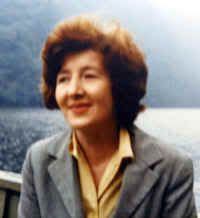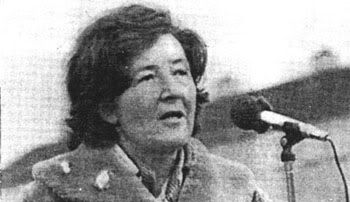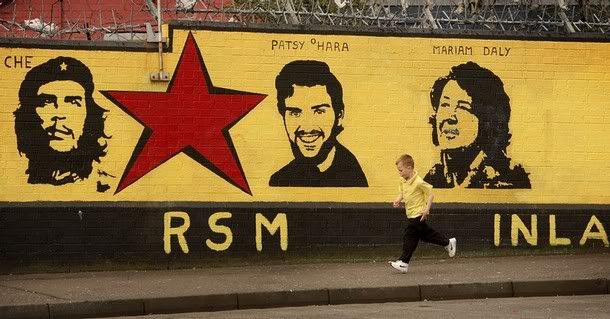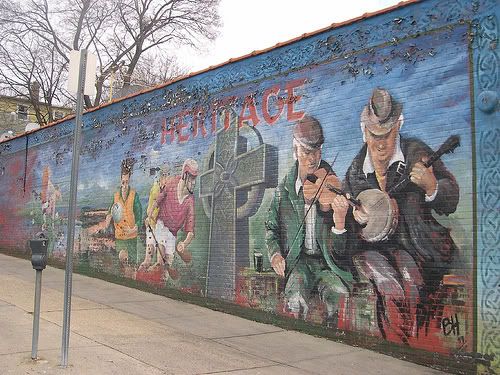
Miriam Daly
—by Jim Daly
Miriam Daly was born in 1928 in the Curragh army camp in Kildare, where her father was an officer of the Free State Army who had served with Michael Collins in the War of Independence and took the treaty side. But Miriam always claimed he had taught her much about insurrectionary politics.
She was brought up in Dublin's Hatch Street, near both her school the Loreto College on St Stephen's Green and University College, Dublin where she graduated in history. She was awarded an MPhil in economic history for research on Irish emigration to England, supervised by George O'Brien. She taught economic history in UCD for some years before marrying Doctor Joseph Lee and moving to England, where she became a lecturer in the History Department of Southampton University. Dr Lee died in 1963. In 1965 she married James Daly, with whom in 1968 she returned to Ireland, where they both became lecturers in Queen's University, Belfast.
The civil rights campaign was taking off at this time, inspired by the black civil rights movement in the US. The imposition of internment without trial by the six county government generated worldwide response. Miriam's organising and public speaking abilities were recognized and welcomed from the beginning. Grassroots activists, who at that time were almost the whole nationalist population of the six counties, were thrilled by the spontaneity and power of her impassioned and wholly genuine rhetoric. They were especially appreciative of the fact that she came from the South to share their oppression and their resistance. She earned the love of internees and their relatives and neighbours by visiting them in what were called their "cages" in Long Kesh to talk about Irish history.
A particular and very popular quality of her style, which perhaps came from her father's background, was that her genuine outrage did not take away her Olympian contempt for the forces of repression, both those of the State and of the loyalist murder gangs with which they were in collusion, even overlapping in membership. Her dynamic presence was felt on television in Ireland, Britain, and France, where she countered the insidious propaganda of the establishment- supported and Nobel Prize- winning -- and pocketing -- "peace" people. Her dynamism extended into her university lectures, where she expressed her convictions with a forthrightness which greatly impressed her students, including the many who came from a non-nationalist background.
Very early on she realised that there was developing a politics of confinement of the struggle to the six counties, and the promotion of an "internal" settlement which would place the inheritors of the great and noble struggle for Irish democracy in the same category as the Ku Klux Klan-like loyalist thugs, and give Britain the paternalistic role of benevolent overseer of a six county settlement. Republicans illustrated their community policing politics with a British army map of Belfast showing streets coloured in green and orange. She failed to get backing for what she saw as necessary, a massive campaign to educate the people in the 26 counties to the realities of the oppression in the six counties -- to make up for their lack of experience of the daily social, political, military, police and death squad oppression. She saw such a campaign as the only way to turn the struggle from a six county civil rights struggle to a national liberation struggle. A friend who agreed such a campaign wasobviously absolutely necessary and the only consistent position for a Republican said "This is becoming a war against internment". The potential campaign, which might have prevented developments like the giving up of articles 2 and 3 of the Irish constitution, which claimed the whole of Ireland as the national territory, was vetoed by the leadership.
Miriam was a militant member of the Prisoners' Relatives Action Committee, and was overwhelmingly voted on to the national Hunger Strike Committee. She founded the highly efficient and effective Murray Defence Committee to save the Murrays from the death sentence in Dublin. In that campaign, she collaborated with Seamus Costello, and soon recognized his politics, especially his opposition to "Ring Road socialism", as the only continuation of James Connolly's politics today. She joined his party, the IRSP. After Seamus's assassination she was elected chairperson, and led the party very successfully for two years. At the time of her death she was in charge of the IRSP prisoners' welfare, and gave a great deal of her time to visiting the prisoners. ____________ _________ _________ _________ _________ _________ _________
Miriam Daly

—from IRSP
IRSP Chairperson / INLA Volunteer Miriam Daly
Assassinated on 26 June 1980
Outspoken republican socialist Miriam Daly, aged 45, was murdered on 26 June, 1980, in her home on Andersonstown Road, Andersonstown, Belfast. Her body, bound and shot, was found by her nine-year-old daughter after she returned from school.
Mrs. Daly, a lecturer in economic and social history at Queen's University in Belfast, was one of the original founders of the Irish Republican Socialist Party with Seamus Costello, and become the party's second chairperson.
She joined a list of martyrs that came to include Noel Lyttle, a fellow republican socialist and committed activist in the H-Block Campaigns, IRSP/H-Block activist Ronnie Bunting, and John Turnley of the Irish Independence Party, all of whom represented the national leadership of the H-Block.
Committee and as such became targets for the state apparatus, and the loyalist paramilitary death squads under its control, in its desire to crush the prisoners' struggle. It was suspected that the same SAS unit that killed Daly also killed Bunting and Lyttle in October of 1980.
Indicating her level of involvement and influence within the movement, a four-man honour guard from the INLA joined the funeral cortege as it halted outside the Daly house in West Belfast on its way to the requiem Mass and fired a volley of shots over her casket in a tribute to the fallen martyr.
Miriam Daly, IRSP Chairperson and INLA volunteer, is buried at Swords, near Dublin, in the Irish Republic.
____________ _________ _________ _________ _________ _________ _________
7 May 2004
Special Report: Miriam Daly
—by Hubert Murphy, Fingal Independent
Buried with her first husband, Dr. Joe Lee and her sister, Kathleen, is Miriam Daly.
People passing the grave, apart from family and old comrades, will hardly stop to ponder about Miriam Daly. But her story is one that deserves to be told.
She was no ordinary woman. A lecturer in economics and social history at Queen's University in Belfast, she was immersed in the Civil Rights issue, then the H-Blocks protest and despite the tense situation, lived life as she wanted � free.
Renowned as a great public speaker and leader, she went on to become a founder member of the Irish Republican Socialist Party.
Aside from her political views, she raised a family with husband James Daly.
In 1952 she had married Dr. Joe Lee, who had a general practice in Dorset Street and family connections in Munster and in Swords. He died in 1953 and was buried in what is now the relatively old part of St. Colmcille's churchyard.
She married James Daly in 1965 in London and the couple moved to Belfast in 1968.
Still living in Belfast, Jim revealed that Miriam was born MacDonnell, with family connections in Dublin and Kildare.
A highly intelligent woman, she went to UCD and would lecture in economic history.
"When I visit her grave I still meet people who remember her funeral," remarked Jim.
One can sense many great memories flooding back into Jim's mind as he comments on her.
"She always had a special affinity with Dunluce Castle on the County Antrim coast, home of the MacDonnell clan. We visited there on her birthday, 16th May, 1980.
"Late in the evening our ten-year-old twins had got out of sight playing around the Castle. I got worried and said I would go and find them. She said "Let them play. They may never pass this way again."
It was to be the last time that Miriam, Jim and the kids would see the place as a family again.
For on June 26, 1980 she was murdered -- on a sunny day in Belfast.
She was found by the kids, coming home from school. She had been bound and shot in the head.
Another family shattered by violence, left with a memory no amount of time will erase.
Nobody was ever brought to justice for her killing, many linking it to collusion between loyalists and the SAS.
There is an indication that a memorial may be erected by her graveside to honour her name, sometime in the future.
But perhaps the greatest tribute is that almost 25 years after her death, her family still mourn her loss, remembering the woman who gave them so much.
____________ _________ _________ _________ _________ _________ _________
26 June 2001
Straight From the Heart
—by Anthony Neeson
Anthony Neeson speaks to Jim Daly, whose wife Miriam, a member of the National H-Block Committee, was murdered by loyalists 21 years ago.
By a strange twist of fate, Jim Daly's father fought on the anti-treaty side during the Civil War while his future wife Miriam's father fought with the pro-treaty forces.
Miriam was born in the Curragh of Kildare in the Free State Army camp there while Jim was brought up in Cheshire in England -- one of the many ironies of post-Civil War Ireland.
When Jim's parents died he was brought back to South Armagh, where future SDLP deputy leader Seamus Mallon would be in his year at school. The party’s future leader, John Hume, was a year behind Jim at Maynooth College.
Miriam, on the other hand, grew up in Dublin and later went to UCD, where she would eventually lecture in Economic History. Fate was to bring them together and it came in the shape of Jim's philosophy professor, who told him there was someone in Dublin he wanted him to meet.
"I've never forgotten that I was introduced to her as as saint," says Jim, laughing at the memory. "She's the only person I've ever been introduced to as a saint. At that time she was already married to Dr Joe Lee, but he died a couple of years later at the age of 37 of a heart attack. And so a couple of years later we were married. Miriam was seven years older than I.
"We were married in London and then I got a job at Queen's University and Miriam got a job soon after at Queen's, so we both came to Belfast in 1968 and moved into Stranmillis, when all hell broke loose."
Miriam immediately immersed herself in the growing Civil Rights movement and was quickly recognised as a talented and passionate public speaker. "What she said was genuine and from the heart," recalls Jim. "She could get a terrific emotional response because whatever she said she felt it herself. She was direct and honest and people responded to that."
Miriam and Jim both became more involved in the political upheaval that was taking place throughout the north and particularly in Belfast, with Miriam contributing to the Republican News. Both joined Sinn Féin. "I would have been a Marxist and would read Marxist literature at that time, but although Miriam was a socialist she wouldn't have got bogged down in Marxist philosophy. Marxists sometimes can't see the wood for the trees because they're looking at the big picture.
Miriam, on the other hand, could very much see the cement."
In 1974 Jim and Miriam were forced out of Stranmillis and moved into Andersonstown. As Jim remembers, a number of people were getting burnt out at the time or were receiving bullets in the post, so they decided that they would be safer elsewhere and so left Stranmillis behind. After the murder of Seamus Costello, Miriam became chairperson of the IRSP at a time when that organisation was flourishing.
Then, as the prison protest in the H-Blocks and Armagh began to escalate Miriam was elected on to the National H-Block Committee at a time when other prominent republicans who were involved with the prisoners and their families were being targeted and murdered.
"We were always wary about our safety over in Queen's because at that time the Holy Land was quite loyalist. But Miriam always said that if they were going to get us it would be here in Andytown, and she was right.-- Jim was in Dublin attending a German language course on June 26, 1980, the day Miriam was murdered.
Earlier that morning he recalls a pleasant domestic phone call, revolving around their two 10-year-old twins, Marie and Donal. The People's Democracy had already informed the pair that they were on a loyalist death list, so they had bought a new heavy mahogany front door and decided to keep the back door locked at all times.
Jim has played over the events of that terrible day many times in his head, but he can't be sure what really happened.
"It appears that Miriam was sitting in the porch enjoying the warm sun and waiting for the kids to come home from school," says Jim. "She must have left the door open when she went to the shop next door to get an apple tart and some cigarettes. When she came back they were waiting for her. That's how she got caught.
"She was shot five times in the head, but they had kept her for a while before, tied her up and held her for some time, which is awful to think about. Then the kids came home and found her."
Miriam Daly was 51 when she was murdered. Although the UFF claimed her murder, Jim still believes that there was higher involvement in her death. At the same time other leading H-Block campaigners such as John Turnly and Bernadette McAliskey were being targeted.
"She came very much to the notice of agencies that were poking their noses in here, for sure. That’s why she was targeted.
“She had a tremendous energy and never stopped. People called her in the middle of the night to come to an RUC station to help out, while relatives would phone her to find out where their loved ones were.
“She never stopped. It was amazing how much dedication she had. She was always upbeat and confident and optimistic. If there is an opposite to demoralise, she moralised people.
"The RUC took away Miriam's handbag, a large book we had with phone numbers and addresses in it and they took my photograph from an international driver's licence. “
There were five spent cartridges lying on the floor which they didn't pick up. They were more interested in political witch-hunting than trying to find out who carried out this murder."
Miriam Daly was buried in Swords, County Dublin. Jim says her death affected many people, and she is continually missed by her many friends and family, not least himself. "I think of her every hour, on the hour," he says with quiet emotion in his voice. " The kids have grown up and are doing very well for themselves. We're getting on..."




